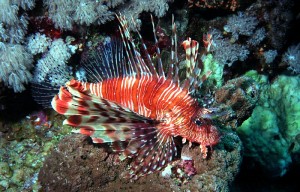by Cora Johnston
This just in: Invasive and venomous lionfish (Pterois volitans) have just been spotted in mangroves along Florida’s Atlantic coast! We encountered two individuals of this invasive species (they’re native to the Indian and Pacific Oceans) while conducting snorkeling fish surveys along the Indian River Lagoon.In their native waters, lionfish are typically coral reef inhabitants. However, they appear to be spreading into surrounding habitats as their population expands across the Caribbean and up the Eastern seaboard. This may be the first documented sighting of lionfish in mangroves in Florida. Although we found one in woody debris just outside the mangroves, the other was spotted snuggled right inside the mangrove roots.
Bad news for mangrove fish! Lionfish are insatiable predators that will eat just about any fish they can nab. When feeding, they shoot a stream of water that spins their prey around so that the lionfish can swallow them head-first. Thus, they can gulp down fish close to their own size. On reefs, lionfish have been shown to reduce the presence of incoming young fish by 80 percent (this research by Mark Hixon at Oregon State University). In short, lionfish could be bad news for small fish hiding out in mangroves—a habitat that normally provides refuge from predators. To see what’s in store, Emily Dark, a SERC intern from Antioch University, will be focusing her summer research on lionfish and their potential impacts on mangrove inhabitants.
More stories from the mangroves
Cora Johnston is a graduate student at the University of Maryland. This material is based upon work supported by the National Science Foundation under Grant Number 1065098. Any opinions, findings, and conclusions or recommendations expressed in this material are those of the author(s) and do not necessarily reflect the views of the National Science Foundation.


